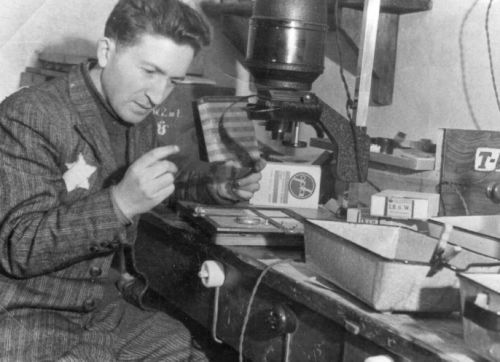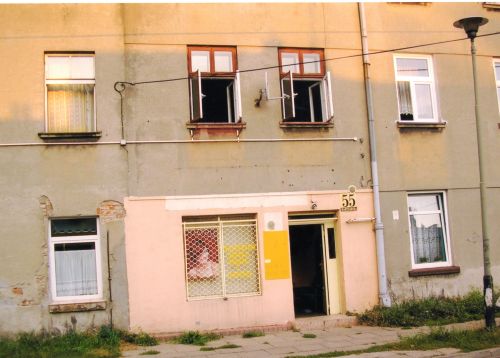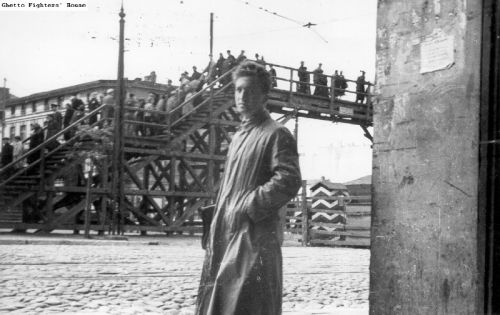Mendel Grossman

Mendel Grossman in his photo studio in the Lodz Ghetto (USHMM)
Mendel Grossman was born on June 27, 1913, in Gorzkowice, to a Jewish Hasidic family. His parents were Szmul Dawid Grossman, and his wife Hanna. After the First World War his family settled in Lodz, and they lived at Wschodnia Street 58. In his early youth he began to draw portraits, as well as scenes from Jewish life. He started to take photographs at first as an amateur, then he became a professional photographer. Mendel even coloured pictures using aniline paints.
In the 1930's, he connected with the Jewish Theatre in Lodz, capturing scenes of the performances, and portraits of actors and actresses. He also knew numerous writers, poets, musicians and painters. Just before the outbreak of the Second World War, the Habima Theatre visited Lodz. Mendel was back stage photographing the performances on his own initiative and directive. The results were the wonderfully inspired forerunner for all of his work in the ghetto, 'Man in Motion.'
During early 1940, the Nazis established a ghetto in the city of Litzmannstadt (the German name for Lodz) and Mendel and his family lived at Marynarskiej 55.

Mendel Grossman's House in the former Lodz Ghetto 2005 (Chris Webb Private Archive)
He found work as a photographer. making identification cards and documenting the work that the Jewish inmates undertook in the ghetto. The Jewish Council of Elders thought these photographs would convince the Nazi authorities to treat the Jews more kindly, because the photographs demonstrated that they were industrious. Grossman also hid his camera in his coat during the day, taking photographs of the living conditions in the ghetto. He took these photographs at great risk to himself, not only because the Gestapo suspected him, but also because he suffered from a weak heart.

Mendel Grossman near the bridge on Koscielny Square (Ghetto Fighters House)
Mendel photographed the results of the deportation 'aktion' in 1942, and he attached himself to the gravediggers. He photographed the open mass graves of deportees from the nearby town of Zdunska Wola. He then made his way to the memorial hall, which was now filled with bodies. While photographing the victims he marked their chests with numbers. The same numbers later appeared on the graves, and thus the relatives were able to identify the graves by first identifying their dead on the photographs. The head of each body was lifted by a gravedigger, and Mendel went from one to another, clicking, recording the bruised, bloody and crushed faces of old people, of boys, and of girls. Some of the eyes were closed, some half open, some stared with fear, some exuded the serenity of death.
Mendel captured with his camera the arrival of deportees from the Reich, and other locations and Mendel took photographs of the mass deportation 'aktions' between the years 1942 to 1944. He photographed the locations where the deportees were concentrated, such as the ghetto jail. In one of the ghetto workshops, a telescopic lens was secretly constructed for him. Mendel could now take photographs from a distance, now concealed from view.
He photographed the convoys of deportees from windows, following them until the deportees entered the wagons at Radegast Station. He took photographs hidden behind a stack of slabs of concrete belonging to a factory of prefabricated houses. The new lens did its work well. Friends warned him against photographing the convoys, because Gestapo men were among the guards, and they would arrest him.
Mendel Grossman also showed particular interest in capturing the activities of youth organisations in the ghetto. There were fewer orphanages and no longer any old people's homes in the ghetto and so he photographed the children in the workshops to which the entire population was mobilised.
He spent his evenings locked in his darkroom, working till late at night. In the mornings he distributed prints among his friends and acquaintances and kept only the negatives for himself. He dismissed every thought of the danger to which he was exposed. However, in the second half of 1944, with the Red Army approaching, the Nazis authorities decided to finally liquidate the ghetto.Mendel knew he must hide his photographic negatives in a safe place. He made a quick selection of negatives, placed them in tin cans, and packed them in a wooden crate. With the help of a friend he took out a window sill in his apartment, removed some bricks, placed the crate in the hollow, then replaced the sill. This 'treasure' was safe for now.
Mendel however, continued to photograph the final deportations out of the Litzmannstadt ghetto during August 1944. Mendel Grossman was deported to the Konigs Wusterhausen labour camp in Germany. He carried on taking photographs, but he could not develop and print them. When the Allies approached the camp, the prisoners were evacuated and forced on a death march. During this death march, Mendel Grossman collapsed on the road, and died, on April 30, 1945 his camera still with him.
After the Second World War ended, the negatives were taken out of their hiding place by his sister Fajge and were sent to Israel. Ten thousand negatives reached Kibbutz Nitzanim. When the kibbutz fell into Egyptian hands during the War of Independence, the negatives were lost. However, not all was lost. One of Mendel's closest friends Nachman Zonabend remained in the ghetto until its liberation. Although the Nazis kept him under constant surveillance, he succeeded in saving the archives of the Judenrat, and he concealed the documentary treasure, including some of Mendel Grossman's photographs, at the bottom of a well.
After the war ended this material was taken out of Poland, and is now housed in the Museum of Holocaust and Resistance at the Ghetto Fighters House in Kibbutz Lohamei Hagetaot, Western Galilee, Israel.
Sources
Mendel Grossman, With A Camera In The Ghetto, Schocken Books, New York, 1977
Lucjan Dobroszycki, The Chronicle of the Lodz Ghetto 1941 -1944, Yale University Press, New Haven and London 1984
wikipedia.org
Photographs: USHMM, Ghetto Fighters House, Chris Webb Private Archive
© Holocaust Historical Society April 14, 2020

